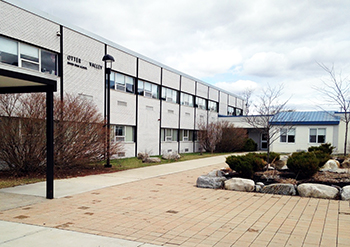Otter Valley High School Invests in Energy Savings
 BRANDON, Vt. — Otter Valley Union High School in Brandon will soon complete major building improvements paid for by significantly trimming the school’s energy costs. The improvements will benefit more than 550 students in grades seven through 12 as well as faculty, staff, parents and visitors. All upgrades will be completed by the end of summer or early fall 2016.
BRANDON, Vt. — Otter Valley Union High School in Brandon will soon complete major building improvements paid for by significantly trimming the school’s energy costs. The improvements will benefit more than 550 students in grades seven through 12 as well as faculty, staff, parents and visitors. All upgrades will be completed by the end of summer or early fall 2016.
Altogether, the project will replace 42 classroom unit ventilators and all windows original to the 1961 portion of the building. A new wood pellet boiler will soon provide most of the school’s heat. Using wood pellets will also help support the forest products industry, an important part of the local and regional economy, as wood pellets are considered carbon neutral.
Other major improvements at the 101,000-square-foot high school include unifying the building’s three separate heat circulation loops and upgrading its heating and ventilation controls system to provide better comfort and efficiency. Crews will also install energy recovery ventilation systems in the gymnasium and auditorium and demand-controlled ventilation in the cafeteria. Interior lighting improvements will include installing efficient and dimmable LED lamps and controls, and all exterior parking lot lighting will be upgraded to LED technology.
The funds supporting Otter Valley Union High School’s various improvements will be generated through energy cost savings efforts completed through a partnership with Milwaukee-headquartered Johnson Controls with assistance from SameSun of Rutland, Vt. Together, the three are implementing a $3.6 million energy performance contract that will help the school dramatically reduce its carbon emissions, paying for the improvements over the next 18 years through substantial energy cost savings, according to a statement by Johnson Controls.
A 227kW solar photovoltaic array on the building’s roof is anticipated to produce half of the electricity used by the school annually, and is on hold pending resolution by the state’s Public Service Board and local utilities, including Green Mountain Power. The school will be incorporating the solar project into its STEM (Science, Technology, Engineering and Math) education efforts, benefiting both education and local taxpayers, as it will lessen the facility’s dependence on electricity from the grid. The solar array and other efforts are expected to reduce the school’s carbon footprint by more than 75 percent.
“We believe the solar project we’ve designed with the help of Johnson Controls and local solar developer SameSun of Rutland has all the favorable characteristics worthy of a ‘Certificate of Public Good’ from the Public Service Board,” said Superintendent Jeanne Collins, in a statement. “It will be located on top of our school, not visible from the ground, and almost all the power it produces will be used on site.”
Otter Valley has budgeted roughly $300,000 annually in recent years to meet its energy needs. When the energy performance contract is fully implemented, the school expects to spend approximately $100,000 per year on heating fuels and electricity. Meanwhile the school will also put $160,000 annually toward paying for the project.
